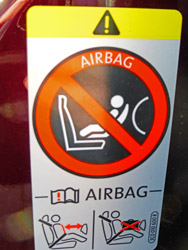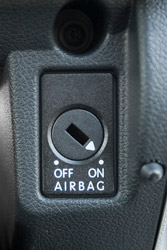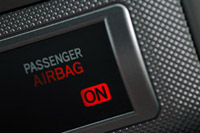Airbags and Child Seats
Many cars have multiple airbags. They are designed to provide extra protection to the occupants in a crash in addition to seat belts.
Most cars are fitted with a driver airbag in the steering wheel and a front passenger airbag in the dashboard. Side airbags, fitted in the vehicle sides or the seats, are also common, and some cars have 'curtain' airbags that drop down in front of the rear seats.
Airbags inflate rapidly (and then immediately deflate), cushioning the occupants and preventing or reducing contact with parts of the vehicle that are likely to cause injury, such as the steering wheel or dashboard. In order to provide protection, airbags fully inflate in less than one second, expanding at anything up to 160mph. This means that they inflate with a considerable amount of force. A car occupant who is too close to an airbag and is hit by it as it inflates, could be injured.
Side airbags are usually a curtain airbag which deploys downward to provide protection to the head and are not as powerful as the front ones. They should not pose a risk to a child in a child seat in the rear, but if anything enhance the protection for the child in its seat.
The following tips will help you to ensure that maximum protection is provided by airbags and unnecessary injuries are avoided (it is sensible to follow these tips even if there are no airbags present).
Child Passengers

- Always ensure that your child is in an appropriate child car seat that is suitable for the car in which it is being used, and that it is securely fitted. Make sure the child is securely held by the child seat harness or seat belt.
- Make sure that children travel in the rear of the car, if possible - it is safer.
- Never put a rearward-facing baby seat in the front if there is an active passenger airbag.
- Do not put a forward-facing child seat in the front, unless there is no other choice. If you must do so, make sure the car seat is as far back as possible, the child seat is securely fitted and the child is securely held by the seat belt or child seat harness, keeping the child as far as possible from the dashboard. Ask the vehicle manufacturer how far the airbag comes out as it deploys and whether it is safe to use a child seat.
- Side airbags are usually a curtain airbag which deploys downward to provide protection to the head and are not as powerful as the front ones. They should not pose a risk to a child in a child seat in the rear, but provide added protection.
- Make sure that the child seat is fitted properly and your child is using it correctly. Try to prevent the child seat leaning close to, or against, the door or window. Of course, children often fall asleep in child seats but seats with side wings will help to stop a sleeping child's head resting against the side window.
- If concerned, contact the vehicle manufacturer to ask how far the side airbags come out if they deploy and whether they are likely to contact a child restraint in the rear outboard seats. EuroNCAP tests include assessing the safety of child seats in a side impact, so check www.euroncap.com to see if your vehicle model is one of those that has been tested.
- If there are other types of airbag in the car, check the vehicle handbook or ask the vehicle manufacturer how far they come out as they deploy and whether it is safe to use a child seat near the airbag.
Adult Passengers
- Always ensure that adult passengers, including children who are too big to use a child restraint, wear their seat belt properly, in the front and the rear of the car.
- The front passenger seat should be as far back from the dashboard as possible. The passenger should sit upright and as far back as possible.
- Passengers should never put their feet on the dashboard, or attach anything to the dashboard over or near the airbag.
- If there are side airbags, make sure that the passenger sits properly in the seat and does not lean close to, or against, the door or window.
- If there are any other types of airbag in the car, check the vehicle handbook or ask the vehicle manufacturer how far they come out as they deploy.
The Driver
- Always wear your seat belt properly.
- Place the driver's seat as far back as possible while ensuring that you can safely and comfortably operate all of the vehicle's controls. There should be at least 10 inches (25 cm) from the centre of the steering wheel and your chest. However, airbags differ from car to car, so ask the vehicle manufacturer for advice about the minimum distance between you and the airbag.
- If you have to sit closer than 10 inches to the steering wheel in order to drive properly, try reclining your seat to move you back sufficiently from the steering wheel, but make sure you can still reach all the controls. If the steering wheel is adjustable, tilt it downwards so that the airbag points towards your chest rather than your head, but make sure you can see the instruments clearly.
- If you still have to sit closer than 10 inches to the steering wheel, ask the vehicle manufacturer for help or advice.
Pregnant Women
- Pregnant women should have their car seats as far back as possible (whether or not an airbag is fitted) and ensure they are wearing their seat belt properly.

Disconnecting or Switching Off Airbags
Disconnecting or switching off an airbag should be a last resort. It means that the protection offered by the airbag is lost. If there is no other option, contact the vehicle manufacturer, and consult your insurance company beforehand.
Some cars have a cut-off switch which allows an airbag to be switched on or off. The disadvantage is that you may forget to switch it back on when a different passenger is in the seat.
Some manufacturers may be prepared to disconnect an airbag or install a cut-off switch if they believe the airbag is causing an appreciable risk to the driver or passenger. They would probably require the vehicle owner to accept responsibility for the disconnection and for any effect it may have on other drivers or passengers. They may need to replace the steering wheel and/or seat belt, if they have been specifically designed and approved for use with the airbag.
The airbag should be reconnected before the car is sold.

Replacement Airbags
If any part of the airbag system requires replacement, ensure only parts approved by the manufacturer for use with the vehicle are fitted. Also make sure that they are fitted in accordance with the manufacturer's instructions.
Never have second-hand airbag components fitted. They may not function properly and therefore, could offer reduced protection, or even present a danger to the vehicle occupant.
Choosing a New Car
When choosing a new car (brand new or second-hand) check with the manufacturer what airbags are fitted and whether they are compatible with your child restraints. Here is a checklist of safety issues to consider when choosing a new car.
